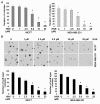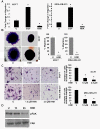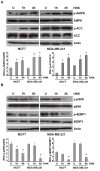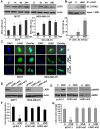Honokiol activates AMP-activated protein kinase in breast cancer cells via an LKB1-dependent pathway and inhibits breast carcinogenesis
- PMID: 22353783
- PMCID: PMC3496153
- DOI: 10.1186/bcr3128
Honokiol activates AMP-activated protein kinase in breast cancer cells via an LKB1-dependent pathway and inhibits breast carcinogenesis
Erratum in
-
Erratum to: Honokiol activates AMP-activated protein kinase in breast cancer cells via LKB1-dependent pathway and inhibits breast carcinogenesis.Breast Cancer Res. 2017 Mar 28;19(1):39. doi: 10.1186/s13058-017-0829-2. Breast Cancer Res. 2017. PMID: 28351375 Free PMC article. No abstract available.
Abstract
Introduction: Honokiol, a small-molecule polyphenol isolated from magnolia species, is widely known for its therapeutic potential as an antiinflammatory, antithrombosis, and antioxidant agent, and more recently, for its protective function in the pathogenesis of carcinogenesis. In the present study, we sought to examine the effectiveness of honokiol in inhibiting migration and invasion of breast cancer cells and to elucidate the underlying molecular mechanisms.
Methods: Clonogenicity and three-dimensional colony-formation assays were used to examine breast cancer cell growth with honokiol treatment. The effect of honokiol on invasion and migration of breast cancer cells was evaluated by using Matrigel invasion, scratch-migration, spheroid-migration, and electric cell-substrate impedance sensing (ECIS)-based migration assays. Western blot and immunofluorescence analysis were used to examine activation of the liver kinase B1 (LKB1)-AMP-activated protein kinase (AMPK) axis. Isogenic LKB1-knockdown breast cancer cell line pairs were developed. Functional importance of AMPK activation and LKB1 overexpression in the biologic effects of honokiol was examined by using AMPK-null and AMPK-wild type (WT) immortalized mouse embryonic fibroblasts (MEFs) and isogenic LKB1-knockdown cell line pairs. Finally, mouse xenografts, immunohistochemical and Western blot analysis of tumors were used.
Results: Analysis of the underlying molecular mechanisms revealed that honokiol treatment increases AMP-activated protein kinase (AMPK) phosphorylation and activity, as evidenced by increased phosphorylation of the downstream target of AMPK, acetyl-coenzyme A carboxylase (ACC) and inhibition of phosphorylation of p70S6kinase (pS6K) and eukaryotic translation initiation factor 4E binding protein 1 (4EBP1). By using AMPK-null and AMPK-WT (MEFs), we found that AMPK is required for honokiol-mediated modulation of pACC-pS6K. Intriguingly, we discovered that honokiol treatment increased the expression and cytoplasmic translocation of tumor-suppressor LKB1 in breast cancer cells. LKB1 knockdown inhibited honokiol-mediated activation of AMPK and, more important, inhibition of migration and invasion of breast cancer cells. Furthermore, honokiol treatment resulted in inhibition of breast tumorigenesis in vivo. Analysis of tumors showed significant increases in the levels of cytoplasmic LKB1 and phospho-AMPK in honokiol-treated tumors.
Conclusions: Taken together, these data provide the first in vitro and in vivo evidence of the integral role of the LKB1-AMPK axis in honokiol-mediated inhibition of the invasion and migration of breast cancer cells. In conclusion, honokiol treatment could potentially be a rational therapeutic strategy for breast carcinoma.
Figures






Similar articles
-
Activation of tumor suppressor LKB1 by honokiol abrogates cancer stem-like phenotype in breast cancer via inhibition of oncogenic Stat3.Oncogene. 2017 Oct 12;36(41):5709-5721. doi: 10.1038/onc.2017.164. Epub 2017 Jun 5. Oncogene. 2017. PMID: 28581518 Free PMC article.
-
LKB1 is required for adiponectin-mediated modulation of AMPK-S6K axis and inhibition of migration and invasion of breast cancer cells.Oncogene. 2009 Jul 23;28(29):2621-33. doi: 10.1038/onc.2009.129. Epub 2009 Jun 1. Oncogene. 2009. PMID: 19483724 Free PMC article.
-
Honokiol activates the LKB1-AMPK signaling pathway and attenuates the lipid accumulation in hepatocytes.Toxicol Appl Pharmacol. 2015 Apr 15;284(2):113-24. doi: 10.1016/j.taap.2015.02.020. Epub 2015 Feb 28. Toxicol Appl Pharmacol. 2015. PMID: 25737164
-
AMPK and Cancer.Exp Suppl. 2016;107:203-226. doi: 10.1007/978-3-319-43589-3_9. Exp Suppl. 2016. PMID: 27812982 Review.
-
Role of the LKB1/AMPK pathway in tumor invasion and metastasis of cancer cells (Review).Oncol Rep. 2015 Dec;34(6):2821-6. doi: 10.3892/or.2015.4288. Epub 2015 Sep 18. Oncol Rep. 2015. PMID: 26398719 Review.
Cited by
-
Design, Formulation and in vivo Evaluation of Novel Honokiol-Loaded PEGylated PLGA Nanocapsules for Treatment of Breast Cancer.Int J Nanomedicine. 2020 Mar 9;15:1625-1642. doi: 10.2147/IJN.S241428. eCollection 2020. Int J Nanomedicine. 2020. PMID: 32210557 Free PMC article.
-
Activation of tumor suppressor LKB1 by honokiol abrogates cancer stem-like phenotype in breast cancer via inhibition of oncogenic Stat3.Oncogene. 2017 Oct 12;36(41):5709-5721. doi: 10.1038/onc.2017.164. Epub 2017 Jun 5. Oncogene. 2017. PMID: 28581518 Free PMC article.
-
Cryptolepine inhibits melanoma cell growth through coordinated changes in mitochondrial biogenesis, dynamics and metabolic tumor suppressor AMPKα1/2-LKB1.Sci Rep. 2017 May 4;7(1):1498. doi: 10.1038/s41598-017-01659-7. Sci Rep. 2017. PMID: 28473727 Free PMC article.
-
Microneedles Drug Delivery Systems for Treatment of Cancer: A Recent Update.Pharmaceutics. 2020 Nov 17;12(11):1101. doi: 10.3390/pharmaceutics12111101. Pharmaceutics. 2020. PMID: 33212921 Free PMC article. Review.
-
Sequential Delivery of Novel Triple Drug Combination via Crosslinked Alginate/Lactoferrin Nanohybrids for Enhanced Breast Cancer Treatment.Pharmaceutics. 2022 Nov 8;14(11):2404. doi: 10.3390/pharmaceutics14112404. Pharmaceutics. 2022. PMID: 36365222 Free PMC article.
References
-
- Fujita M, Itokawa H, Sashida Y. [Studies on the components of Magnolia obovata Thunb. 3. Occurrence of magnolol and honokiol in M. obovata and other allied plants] Yakugaku Zasshi. 1973;93:429–434. - PubMed
Publication types
MeSH terms
Substances
Grants and funding
LinkOut - more resources
Full Text Sources
Medical
Research Materials
Miscellaneous

